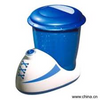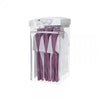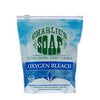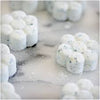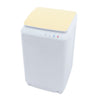Denim
If you need to soak denims, use cool water and an enzyme pre-wash compound.
Detergents
Liquid detergents usually do a better job of removing greasy, oily stains, whereas powdered detergents are normally cheaper and better for removing mud and clay. Another advantage of powders is that they are often better at preventing mineral stains from iron and other minerals in the water. Note to environmentally-conscious consumers: leading brand detergents contain a number of undesirable ingredients, and powdered detergents often contain plastic fillers.
Diapers
Rinse soiled diapers immediately, and soak in a diaper pail with water 1/2 cup borax or high quality oxygen bleach. When washing, make sure to use a second rinse to make sure all the detergent is removed (babies’ skin can be irritated by detergents). Many people find our compact Wonderwash washing machine, which is only $42.95, useful for washing diapers.
Digestants
Digestants work on the Pac-man principle- the enzymes in them eat the bad guys (stains). Be careful not to use digestants on animal fibers such as wool or silk, or the fabric itself will get digested along with the stain.
Doilies
Old, fragile or handmade doilies should be gently handwashed in Eucalan Woolwash or another mild laundry detergent. Starch can help doilies keep their shape.
Dolls
In general, cleaning will not necessarily restore dolls to “new” condition, but it’s better than not cleaning them at all. Newer dolls come with cleaning instructions, but if you’re unsure, surface washing is recommended for all but the most delicate (and expensive) of dolls. Any doll that walks, talks, or moves in any way or has electrical or mechanical parts should never be submerged in water. Older dolls with bisque or porcelain parts may not have had a sealer applied over the face, and water could wash the paint right off their faces. To surface wash: Wipe with a sponge dampened in an all-purpose cleaner solution. For really stained dolls, you can use a soft-bristled toothbrush. Ink often cannot be removed, but can sometimes be bleached out by sunlight. Machine washing: The only dolls that should be washed in an automatic washer are those that say so on the label. These are usually made entirely of cloth, stuffed with polyester or other washable fiber filling. Some dolls’ heads can be removed and their clothes run through the washer. Hair care: To wash synthetic and real hair, use a mild shampoo, rinse, and allow it to air-dry. Note that curly hair will not be nearly as curly after it is wet, and synthetic hair cannot be reset, so unless it’s absolutely necessary, avoid washing doll locks. If you know for a fact that a doll’s hair is made of human hair or mohair, don’t wash it unless you are prepared to redo the hairdo. For tangled hair, use a wig brush. Yarn hair should be washed in Eucalan Woolwash or another woolwashing detergent.
Dry Cleaning
Dry cleaning refers to a cleaning process where solvents (usually petroleum solvents) are used instead of water. Fabrics that water might shrink, warp or cause to lose color are usually dry cleaned. Dry cleaning is not dry at all, rather, the clothes are dipped in a solvent. In most cases this solvent is perchlorethylene, or PERC. In 1995 the International Agency for Research on Cancer (IARC) classified PERC in group 2A, meaning that it is probably carcinogenic to humans. Fortunately new techniques such as wet cleaning can be used to effectively wash dry-clean only clothes without the use of hazardous substances such as PERC.
Dryers
For best results and to prevent fires, clean the lint filter or screen before each load. Lint can also collect in the exhaust duct and inside the rear panel on electric dryers, or around the burner on gas dryers and create a fire hazard (contrary to popular belief, the lint trap does not catch all the lint).These parts of a dryer should be cleaned by a professional serviceperson every two to three years.

